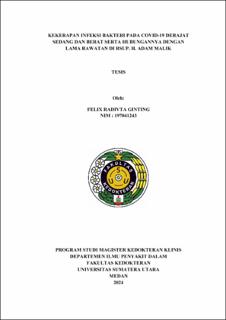Kekerapan Infeksi Bakteri pada Covid-19 Derajat Sedang dan Berat serta Hubungannya dengan Lama Rawatan di RSUP. H. Adam Malik
Frequency of Bacterial Infections in Moderate and Severe Covid-19 Cases and Its Relationship with Length of Hospitalization at RSUP. H. Adam Malik

Date
2024Author
Ginting, Felix Radivta
Advisor(s)
Ginting, Franciscus
Saragih, Restuti Hidayani
Metadata
Show full item recordAbstract
Introduction In December 2019, pneumonia cases with unknown causes emerged in Wuhan, China, leading to the discovery of the novel coronavirus SARS-CoV-2, which causes COVID-19. The disease ranges from mild symptoms to severe complications such as pneumonia, multi-organ failure, and death. Bacterial co-infections in COVID-19 patients exacerbate the severity of the disease and can prolong hospital stays. This study aims to investigate the frequency of bacterial infections in moderate to severe COVID-19 cases and their relationship with the length of hospital stay at Haji Adam Malik General Hospital. Methods A retrospective cohort design was employed, analyzing medical records of COVID-19 patients treated from January to June 2021. The study included patients aged 18 or older with confirmed COVID-19 and signs of bacterial infection. Data collected included demographic information, lab results, COVID-19 severity, and hospital stay duration. Statistical analysis was performed using descriptive statistics and the Chi-square test to assess the relationship between bacterial infections and the length of hospital stay. Results Out of 995 COVID-19 patients, 81 (8.1%) had bacterial infections, with a higher incidence in severe cases (11.8%) compared to moderate cases (5.3%). Infected patients had a median age of 58 years and were predominantly male (60.5%). The majority of bacterial infections were detected in sputum samples (66.7%). Patients with bacterial infections had significantly longer hospital stays, averaging 13 days, compared to 8 days for non-infected patients. The most common pathogens were Acinetobacter baumannii, Klebsiella pneumoniae, and Pseudomonas aeruginosa. Conclusion The study found that bacterial infections are present in 8.1% of COVID-19 patients, with a higher prevalence in severe cases. These infections are associated with longer hospital stays. The findings underscore the importance of accurate diagnosis and appropriate management of bacterial co-infections in COVID-19 patients to improve outcomes and reduce hospital stay durations. Future research should consider factors such as prior antibiotic use and comorbidities to provide a more comprehensive understanding of the impact of bacterial infections on COVID-19.
